December 28, 2004
Louisiana Walk #14
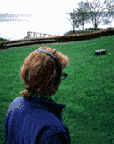
Real and Fabricated Collage
Louisiana Walk #14--by Janet Cardiff--is a 13 minute binaural audio piece that guides participants through the sculpture park of the Louisiana Museum, (Denmark) with a walkman. The audience member listens to a collage of sounds that shift from what is perceived to be the actual sounds of the park to completely fabricated soundscapes. They also hear the sound of the body, footsteps, and voice of the person giving instructions and thoughts. The use of the headset and binaural sound creates an eerie personal space that the listener enters into, almost as if entering into someone else's mind and body. Even though the format plays with that of the museum audio tour the listener finds out very soon that they have become part of a virtual space that hovers between a science fiction thriller and a personal journey.
Janet Cardiff was born in Brussels, Ontario, Canada, in 1957. She studied at Queen's University (BFA) in Kingston and the University of Alberta (MVA). She currently lives and works in Lethbridge, Alberta.
Her artworks, whether they are installations or walking pieces, are mainly audio based. She has been included in exhibitions such as: "Sculpture Projects", Muenster, 1997, "Present Tense, Nine Artists in the Nineties", SFMOMA, "NowHere", Louisiana Museum, Denmark, "The Museum as Muse", MOMA, Sao Paulo Bienal '98, 6th International Istanbul Biennial, The Carnegie International '99/00, "The Tate Modern Opening Exhibition" as well as a project commisioned by Artangel in London. Her work is included in private and public collections in Canada, the United States and Europe.
Janet is represented by Luhring Augustine Gallery, NYC, and Barbara Weis Gallery, Berlin.
( text from abbeymedia.com)
Posted by jo at 10:14 AM | Comments (0) | TrackBack
Confess
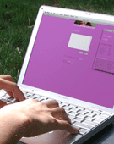
Web of Truth
Begun as a private experiment, New York-based artist Stewart Smith's Confess project soon took on a life of its own by virtue of its own logic: users sign up with anonymous accounts, and are given the opportunity to bare their souls into an internet confessional. In return, they are allowed to view the anonymous confessions of other users. Users can comment (again, anonymously) on what they view, and see the comments of others on their own secrets. The only control that the process has is a rating system; the 'better' one's confessions are rated, 'better' are the confessions one will see, setting up an addictive emotional economy. Sherman has kept the presentation deliberately minimal, giving the site a personality that is both earnest and vaguely unnerving, reflecting the ambiguous feelings provoked by impersonal honesty. The effect of sitting down in front of the screen and being asked to communicate without consequences is strangely powerful, and the results stir interesting thoughts about the fate of sincerity on the web. - Ben Davis, Net Art News, Rhizome, December 20, 2004.
Posted by jo at 09:00 AM | Comments (0) | TrackBack
December 27, 2004
netzwissenschaft
![]()
Emerging Infrastructures of All (Inter)net Research
Dr. Reinhold Grether's network research | netzwissenschaft site maps the "emerging infrastructures of all (inter)net research endeavours. net.science as an anthropology of connectivity is trying to overcome the constraints of specialist method transfers on net matters. the protuberance of technical networks necessitates a professionalization of human net knowledge. neither the isolation of concepts as in basic research nor the encapsulation of processes as in applied sciences will ever be able to adequately describe the complex autopoiesis of networks. net.science is undoubtedly developing into a scienza nuova of its own right."
Check out his Mobile Art and Virtual Performance research areas.
Posted by jo at 04:45 PM | Comments (0) | TrackBack
November 24, 2004
Mulholland Drive
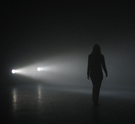
cinema sans image
In Mulholland Drive by D. Scott Hessels, three artists drove Los Angeles' famous Mulholland Drive with five types of sensors—measuring tilt, altitude, direction, speed, and engine sound. The captured data was used computationally to control two robotic lights in a dark room filled with fog. Two beams of light and the processed sound of the engine recreated the topology of the road as a new form of visual experience and sculpture—cinema without image.
Mulholland Drive is a light installation that translates the movement across a topology as two beams of light. Instead of direct human interaction, the work takes the sensed data (tilt, sound, and GPS) of traversing an environment and recreates the drive through angles, light, and sound. A passive interactive experience, the artwork emphasizes the spatial quality of light—it is cinema without image. Like cinema, direct data is captured, then edited, and shaped. However, here the environment directly defines the experience, using the geography computationally. In a sense, “Mulholland Drive” is a new media Earthwork and demonstrates how suddenly the rhythms, patterns, and random chance of the environment can be sensed through new media technologies and used to create new forms of visual experience.
Producing under the name Damaged Californians, Scott Hessels has released experimental art and commercial projects in several different media including film, video, web, music, broadcast, print, and performance for the last decade. His work has shown in international film and new media festivals, on television, and in contemporary art galleries. He recently completed a commission of three interactive films and six online movies for Australia and was honored with a career retrospective at the Melbourne International Film Festival. As a media artist, his installations have shown at CiberArt in Bilbao, the Hammer Museum in Los Angeles, and the Japan Media Arts Festival. Professionally, as Director of Information Technology for Fox Television, he was responsible for the systems, software, communications, and security for two television stations and two cable networks…a career he followed for 25 years. He currently teaches digital video at UCLA in the Design | Media Arts Department and is studying for his graduate degree in that field.
Posted by jo at 01:00 PM | Comments (0) | TrackBack
November 23, 2004
The Gambit
![]()
The Narrative Abilities of Flowers
The Gambit is a portable interactive animation sited in the lobby of the Westin-Bonaventure Hotel (John Portman, 1977). The medium of the project is a digital compass attached to a PDA ("personal digital assistant") with a two and a quarter inch by three and a quarter inch color screen and headphones. This apparatus worn by the viewer displays images of spaces normally inaccessible to the viewer's vision from within the Westin's lobby, in other words, as if you're seeing through walls with a kind of periscope.
The "seeing through the walls" has a shape, like Gordon Matta Clark's cuts through buildings. The shape is configured by animated still images and sound. The still images and sound tell a story. The story is of a hotel flower arranger, and of a parallel world where flower arrangements have archival and narrative abilities. The Gambit is a project of Kati Rubinyi.
Posted by jo at 09:45 AM | Comments (0) | TrackBack
November 15, 2004
Mobile SCOUT

"Our Automated Quirky Naturalist"
Mobile SCOUT A Mobile Phone and Web Public Art Project by Julian Bleecker, Scott Paterson and Marina Zurkow: are you in a concrete jungle or swamped by tourists? Who's around you, what do you see? A deer, a dump or a daydream? Saintly acts or sinful facts? Mobile SCOUT is a public art project that collects audio narratives of your local surroundings, personal rituals and public sightings. Using your mobile phone, you leave a voice message of your observations with the Mobile SCOUT Ranger, our automated quirky naturalist.
Turn your observations into a brief message about the flora (landscapes), fauna (characters) or behaviors (events) that populate your surroundings. Call the Mobile SCOUT Ranger - 1 (877) 564-3060 - he will guide you through the experience. [via]
When you call you'll:
* pick your mission (flora, fauna or behavior)
* pick two habitat attributes
* leave a recording
Further instructions for operating Mobile SCOUT are available at our online brochure. Mobile SCOUT defines place as being made of social habitats, not geography. Your recordings are organized into an audio/visual field guide according to the kind of space you occupy, be it play, work, nature, culture, public, private, branded or free speech. See the field guide and listen to recordings left by others by visiting the web site.
Mobile SCOUT was commissioned by "The Database Imaginary", an exhibition at the Walter Phillips Gallery at The Banff Center, and curated by Sarah Cook, Steve Dietz and Anthony Kiendl. Mobile SCOUT was produced with support from BeVocal for voice application hosting.
Posted by jo at 11:21 AM | Comments (0) | TrackBack
November 06, 2004
The Book of Rage and Longing
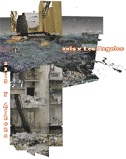
Raging by the Book
In ancient Greek comedy, parabasis named 'a part sung by the chorus, addressed to the audience in the poet's name, and unconnected with the action of the drama.' Calling themselves 'the bodies of rage and longing,' six artists and filmmakers based in the United States - Dimitri Kotsaras, Mr. Flo, Melissa Longenecker, Jennifer Nelson, Michael Wilson, and Natalie Zimmerman - have devised an ongoing, collaborative project to promote parabasis transnationally. With foci in Los Angeles and Athens, The Book of Rage and Longing stages an interrogative return to the putative birthplace of Western democracy. Viewers submit textual or visual rants, connected or unconnected with the daily unfolding dramas of wars worldwide. Unedited, these texts and images are projected on a rooftop facing the Acropolis. An 'interpretive/administrative committee' modifies these contributions, reshaping them into the titular book, segments of which a group of Greek singers then performs. Rea! d in the aftermath of this year's presidential election, these instances of parabasis have begun to seem rather more tragic than comic, as when one self-styled poet opines, 'From those who live like leeches on the people's lives,/ We must take back our land again,/ America.' - Ramsey McGlazer, Rhizome's Net Art News, November 5, 2004
Posted by jo at 10:25 AM | Comments (0) | TrackBack
October 13, 2004
CITYchromosomes

Fixed Points Gathering Impressions
The Stadschromosmen (CITYchromosomes) project gathered thoughts and impressions of particular points around Antwerp and its districts that were shared via SMS. There were 25 ‘text points’, each inviting the submission of impressions about that place. After six months, a selection has been compiled into a booklet that combines the different ‘text points’ and gives an alternative view on Antwerp and its districts. The booklet (in Dutch) is available for download in PDF, plain text and a special version for iPods. By November 15, a complete English translation will also be available under the creative commons license.
"It’s been a fantastic, city-wide...event, put together against the odds and with very little support...by Stefan Kolgen and Ann Laenen of C.H.I.P.S, and including brilliant things like them spending a night turning all the city’s buses into Stadschromosomen text points and leading a walk with 200 recent immigrants round the city, asking them to text in their feelings about the landmarks of their new home town." FishArePeopleToo
STADSchromosomen is CityPoems’ sister project in Antwerp, Belgium, UNESCO's World Book Capital 2004. CityPoems and STADSchromosomen have 'twinned' matching locations in Leeds and Antwerp, to let you use your mobile phone to be in two cities at once.
Posted by jo at 03:05 PM | Comments (1) | TrackBack
Cinéma
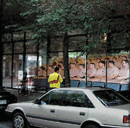
Shuttled Between Worlds
Cinéma is a multi-artist, cross-disciplinary performance presented in a storefront, converted into a theatre which looks out onto an urban streetscape. The audience inside this theatre watches and listens to video and sound elements while live performance takes place on the street outside. Narrative elements in Cinéma are in both French and English. Cinéma opens with texts which deal with the nature of the first word, the dominance of the ‘cinematic eye’ in our experience of the world, and the fragility of the human body. The myth of Orpheus and Eurydice, with its shuttle across the transitional space between the worlds of the living and the dead, is used as a structuring device for the piece.
Cinéma will be presented at SAT (Society for Art and Technology/La Societé des arts technologiques), 1195 rue Saint-laurent, Montréal [between René-Levesque et Sainte-Catherine - métro: Saint-Laurent]; October 12-15, 2004 at 8pm. During the day visitors can sit in the theatre observing the street while listening to an audio piece in which fragments of the performance soundtrack are adapted as an installation.
Thematically, the use of the myth is of interest in examining the very contemporary problem of the ability of art to influence the unfolding of events. What is the use of art in the face of political and social conditions which appear to be beyond our control? Can art create a window onto invisible forces which seem to control our lives? Can it open a process which allows us to approach spiritual and existential questions without falling into romantic clichés? In short, what is the potential relevance of art beyond its contemporary relegation to the role of diversion and entertainment?
Music: Rainer Wiens
Texts: Shauna Beharry, Andrew Forster
with: Monique Romeiko, Robert Schweitzer, Solomón Díaz, Michael Fernandes, Nathalie Claude
Posted by jo at 09:33 AM | Comments (0) | TrackBack
October 11, 2004
Platfrom

Routed Narratives
Platfrom, by Rachel Baker, uses the platform of the mobile phone within a very specific context the train journey. A series of playful SMS messaging scenarios will make a relation between mobile phone and rail network as communication systems. Focusing on privatised, proprietary networks the railway and the mobile phone the project will invert them into opportunities for public and group interaction. It offers moments for train culture and SMS culture to integrate, taking advantage of a journey's incidental nature (delays etc.) with unknown consequences by creating a common gateway between train traveller and static web user and including them both in a narrative along a particular route. The narrative at this stage is dictated by the route from South to North and the contiguous cities and landscape. Read more [PDF]. Also read an essay by Matt Locke.
Posted by jo at 11:52 AM | Comments (0) | TrackBack
October 08, 2004
IMPLEMENTATION
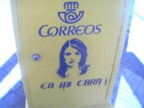
Distributed Serial Novel
Implementation is a novel about psychological warfare, American imperialism, sex, terror, identity, and the idea of place, a project that borrows from the traditions of net.art, mail art, sticker art, conceptual art, situationist theater, serial fiction, and guerilla viral marketing. The text is being written collaboratively by Nick Montfort and Scott Rettberg with some contributions from others. Its initial incarnation is as a serial novel printed on sheets of stickers that are being distributed in monthly installments.
"We will distribute these sheets to individuals, both personally and via post...We will deploy Implementation internationally and work to bring it into unusual geographical and cultural contexts. We will encourage the translation of texts into other languages and will host any translations that are done on the project website."
Posted by jo at 08:27 AM | Comments (0) | TrackBack
October 07, 2004
News Reader, by Noah Wardrip-Fruin, David Durand, Brion Moss, and Elaine Froehlich

Playing the Daily News
News Reader, the second of two textual instruments commissioned by Turbulence, is software for reading and playing the network news environment. Initially, it offers the current "top stories" from Yahoo! News which are always drawn from mainstream sources. Playing these stories brings forth texts generated from alternative press stories, portions of which are introduced (through interaction) into the starting texts, gradually altering them. "News Reader" is an artwork designed for daily use, providing a sometimes humorous, sometimes disturbing experience of our news and the chains of language that run through it.
"Two Textual Instruments: Regime Change and News Reader" is a 2003 commission of New Radio and Performing Arts, (aka Ether-Ore) for its Turbulence web site. It was made possible with funding from the LEF Foundation.
Posted by jo at 06:37 PM | Comments (0) | TrackBack
September 14, 2004
UpStage

UpStaging Performance
A new medium for online performance, theatre and storytelling is now in its first release. UpStage is a web-based venue and tool for artists to compile different digital media for textual and audiovisual communication into a live performance, in real time, for online audiences.
The first release of the software was launched on 9 January 2004, and online walk-throughs were held on in February to give people an idea of how UpStage works from the player's perspective. These sessions will be continued on a regular basis, lead by the members of Avatar Body Collision. If you are interested in having a hands-on experience with the software, and participating in live improv sessions, email colliders at upstage.org.nz for further information and to be notified of times. Visit the UpStage foyer, from where you can access a sample stage.
Currently, UpStage is being used for WorldX, a virtual exchange between schools in the UK and New Zealand, and DTN2, the first cyberformance using UpStage, was performed live from the Machinista Festival in Glasgow on Sunday 9 May.
Posted by jo at 06:09 PM | Comments (0)
August 25, 2004
contagion
Jill of Jill/txt has observed a new kind of narrative emerging from the net, what she calls "distributed narrative" or "viral narrative" or sometimes, "contagious narrative." It's narrative that doesn't try to be a total or complete artwork but sends "fragments and shards across media, through the network and sometimes into the physical spaces that we live in." It's a "book without end." She likens it to distributed computing, which spreads processing across many computers, attaining as much or more power than is possible in a single supercomputer.
Jill references Tim Etchell's (see also Forced Entertainment) work, Surrender Control, where the reader receives SMSs asking her to do things that carry the narrative into her physical world.
So with "viral narrative." It asks the reader to take it up and pass it on to places it has never been. To become a performer on its behalf.
Jill will be writing more about this viral narrative in the upcoming months.
Posted by newradio at 11:47 AM | Comments (0)

